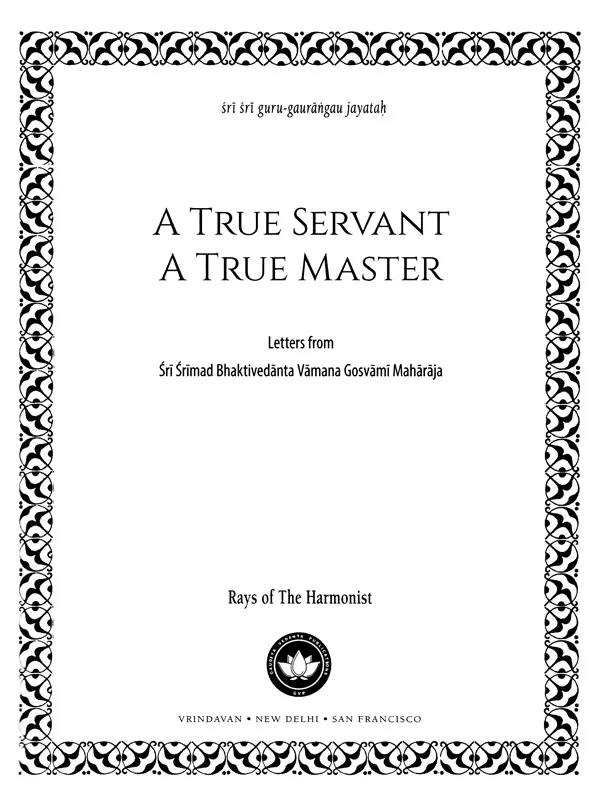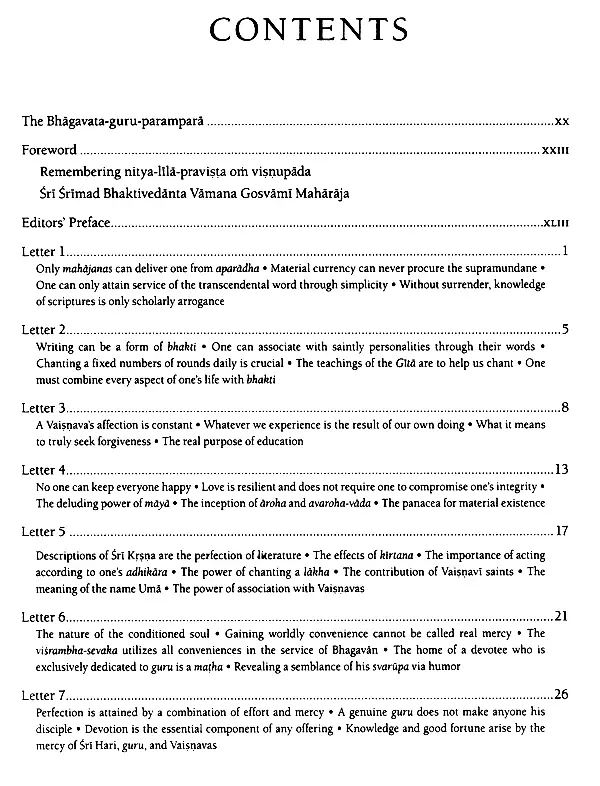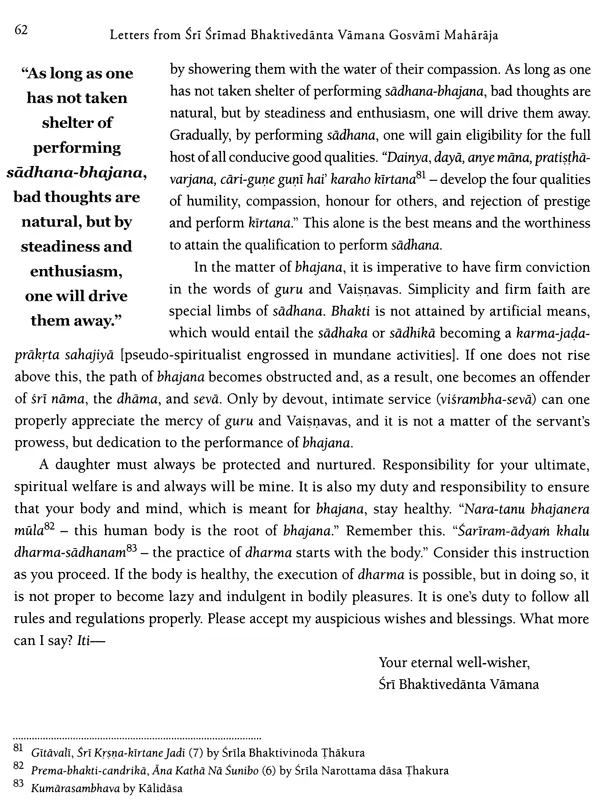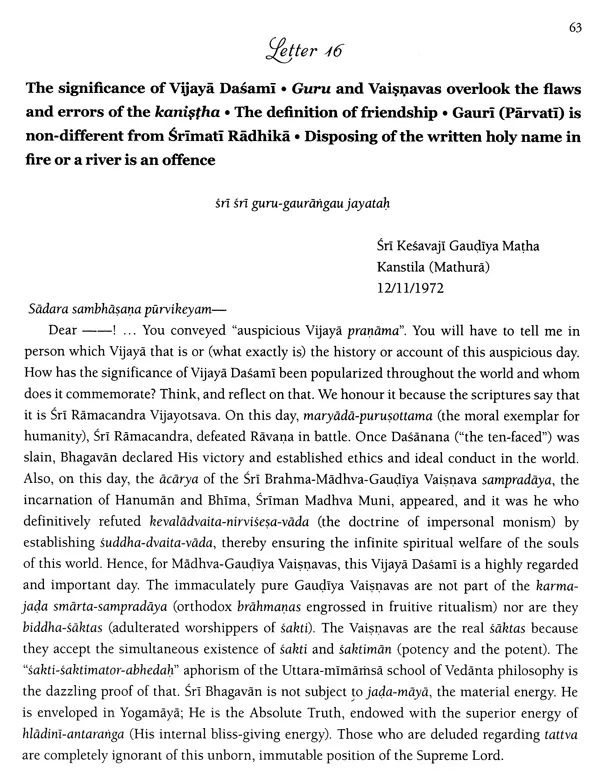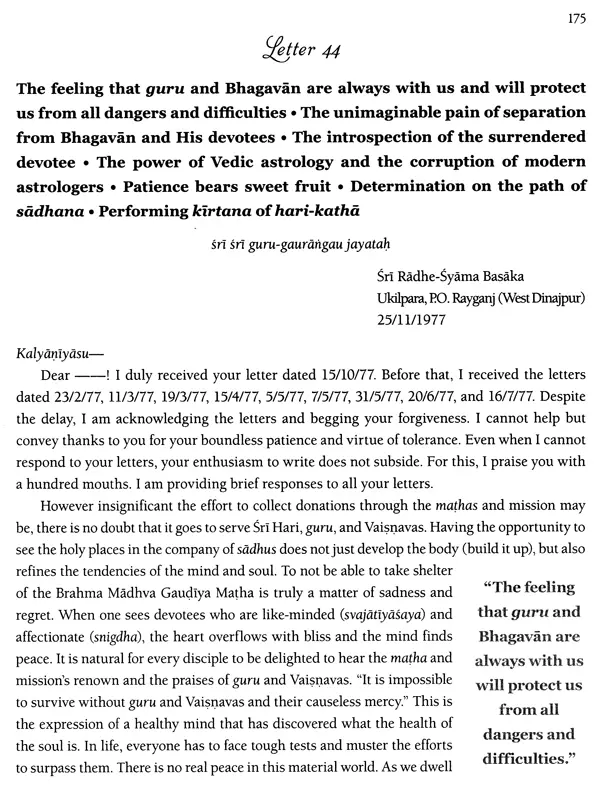
A True Servant: A True Master
Book Specification
| Item Code: | UBB094 |
| Author: | Bhaktivedanta Vamana Gosvami Maharaja |
| Publisher: | Gaudiya Vedanta Publications |
| Language: | English |
| Edition: | 2021 |
| ISBN: | 9781633162051 |
| Pages: | 483 |
| Cover: | HARDCOVER |
| Other Details | 9.50 X 7.50 inch |
| Weight | 860 gm |
Book Description
A True Servant, A True Master presents a treasury of Gauḍīya Vaiṣṇava con ceptions. The letters were composed by a pure Vaiṣṇava, an exemplar of the elevated ideals he imparts, and therefore carry spiritual potency. They are more than just words or advice.
A true saint is unphased by any manner of situation and predicament presented to him, and with genuine concern, he imparts spiritual guidance to elevate and inspire. Transcendental wisdom and even humour flow through the author’s pen from his heart, in letters containing such nuanced under standings of the authentic path to pure bhakti that the serious practitioner can revel in a wealth of life changing understandings.
Srila Bhaktivedanta Vämana Gosvāmī Mahārāja was born in 1921 in East Bengal. At age nine, he left kith and kin to devote his entire life to his spiritual preceptors - Śrīla Bhaktisiddhanta Sarasvati Thakura Prabhupada and Śrīla Bhakti Prajñāna Keśava Gosvāmī Mahārāja. He lived as an ascetic within the monasteries of Śrī Gauḍīya Vedanta Samiti, which in his later years were entrusted into his caring charge, and he simultaneously propagated the message of Śri Caitanya Mahaprabhu throughout India.
It is rare in this world to find a leader who is disinterested in the power and position accompanying their post, but through these letters, we have the opportunity for such an encounter. His dedicated disciples and followers, numbering tens of thousands, con- fidently bear testimony to this. In 2004, he departed from this world in Śrī Navadvipa- dhama, leaving for us a mine of instructions for our ultimate welfare, conveyed through his many articles and loving letters.
This presentation of the English rendering of a hundred and twenty-eight handwritten letters of nitya-ila-pravista om visnupada Sri Sring of a handed and (antana: Gosvami Mahārāja is being published on the occasion of his centennial appearance (December 28, 2021). It is the result of Srila Gurudeva Sri Srimad Bhaktivedanta Narayana Gosvami Maharaja's utmost reverence for his beloved god-brother, whom he regarded as his stksa-guru and who dedicated his whole life and soul to their guru mahārāja, nitya-lila-pravista om visnupada Sri Srimad Bhakti Prajñana Kesava Gosvāmi Maharaja. The Foreword contains Sri Srimad Bhaktivedanta Narayana Gosvámi Maharaja's fond memories and profuse glorification of Sri Srimad Bhaktivedanta Vamana Gosvami Mahārāja, and Letters 121 and 125-127 reveal something of the sweet affection and encouragement Sri Srimad Bhaktivedanta Vamana Gosvami Maharaja showered upon Sri Srimad Bhaktivedanta Narayana Goswami Maharaja. The intimate bond of trust and affection these two personalities shared has long been a source of inspiration for devotees around the world. By his sweet remembrances and continual glorifications of Sri Srimad Bhaktivedanta Vamana Gosvami Maharaja, Sri Srimad Bhaktivedanta Narayana Gosvámi Maharaja has sowed the hearts of his own disciples and followers with an ever-growing desire to learn more about this extraordinary personality and his exemplary life and teachings.
Nourishing that seed and our appreciation is Srimati Uma Didi, who has provided the more recent inspiration and blessings that have made this collection of letters a reality. A simple and humble Vaisnavi, she does not advertise her depth of spiritual realization or the great fortune she has had since 1970 to associate with and serve both Sri Srimad Bhaktivedanta Vamana Gosvami Maharaja, her diksi-guru, and Sri Srimad Bhaktivedanta Narayana Gosvami Maharaja, her siksa-guru. But she wanted to share with others the wealth of spiritual encouragement and guidance she has long treasured and cultivated. Sri Srimad Bhaktivedanta Vamana Gosvami Maharaja wrote over thirty letters to her between 1970 and 1987. Since many devotees know Uma Didi and have personally witnessed her devotion to her gurus and her impeccable sadhana, we have included her name at the start of those letters. That lengthy correspondence offers some of the most beautiful teachings and examples of the loving relationship between guru and disciple. Otherwise, most of the names in these letters were redacted in their original Bengali publications and were therefore unavailable to us.
What is vyāsa-pūjā?
What is vyasa-paja? In a general sense, the full moon day that comes in the month of Asadha W June-July) is called Guru Porns, and it to the appearance day of Sir Vyasadeva, so everyone offers puspanjali at his feet on that day This is observed in our sampradaya and in many other sampradayas as well.In our sampradaya, those who sit upon the seat of Sri Vyasadeva and preach and practise the message of Srimad Bhagavatam are acaryas On the acarya's appearance day, the worship he himself performs of his own guru and the guru-parampara is called vyasa-puja Vyasa-pújä does not mean that the guru seeks to accept worship from his disciples and followers. Rather, on his birthday, he worships his own gurudeva as well as the Vaisnavas, the guru-parampara, and his worshipful deities, Sri Sri Radha-Krsna and Caitanya Mahaprabhu. This is called vyasa-puja.
Look at the example of Sri Nityananda Prabhu, or more recently, as you all must have seen. our worshipful nitya-lila-pravista om visnupada Sri Srimad Bhakti Dayita Madhava Gosvami Maharajaji. On his appearance day, he would worship all the Vaisnavas and Vrajavasis who came. He would give them garlands, tilaka, and fresh clothes. He would even give garlands, and so much honour to those who are on the level of his disciples, the disciples of his god- brothers like myself.
If this manner of conduct is not taught, then as we see today, people just think, "Oh, guru- pája, vyasa-puja, means my disciples will worship me." This is the opposite of puja, this is not puja. Surely, even if the disciples see this misdirected sort of paja, they will at least learn to worship their guru. They should certainly perform puja of their guru, otherwise problems will come. But if the guru himself does not set an example of worshipping his own guru and his guru-varga, then what kind of puja will his disciple learn to perform?
Book's Contents and Sample Pages
